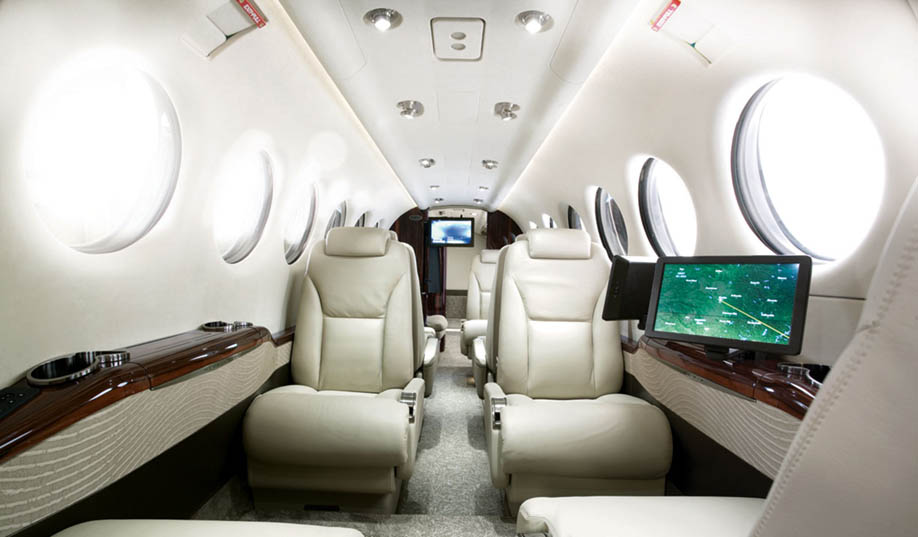Beechcraft CEO Bill Boisture on Bumpy Skies and Soaring High
A streamlined process and renewed market focus has made the aircraft manufacturer’s profits soar.
In the rising aircraft market of 2007, Hawker Beechcraft looked like a good, synergistic investment for Goldman Sachs and OneX when they bought the company, which featured both business jets and turboprop planes along with a service business. So the investment partners each invested $500 million in the company and took on $2.2 billion in debt.
However, the investors consummated the deal just before the economy started faltering in 2008. As the economy stumbled and fell sharply, the size of the company’s market fell an estimated 40 percent, leaving the highly leveraged company with a heavy load of debt.
Fuel prices were on the rise as well, but in the scheme of things, that was only a minor issue, according to Bill Boisture, CEO of what recently became Beechcraft Corp. “The main thing was a lack of confidence. Our customers were wondering where the bottom was,” says Boisture (click to tweet this!).
With financial markets still trending downward, Boisture and team worked hard to reshape the company. “In 2009, we reduced our head count by 2,500 people and shut down some product lines in business jet manufacturing that were losing money. We made the decision that we had to restructure the company. We had to cut the costs, [further] reduce the head count, and eliminate the nonproductive product lines,” says Boisture.
Hawker Beechcraft had a much stronger turboprop market, according to Boisture, and a weaker jet market. Additionally, the turboprop market tends to be more stable in terms of products and customer preferences.
Looking back, Boisture says the company likely would have been able to avoid bankruptcy altogether if it had not been in the jet business, though “it would have been tight.”
But as the company was structured at the time, there was no way to stay in business, even with all of the changes, without going into bankruptcy, which it did in May of 2012.
Prearranged Bankruptcy Filing
Beechcraft chose a prearranged Chapter 11 filing under which the major creditors would become the owners post-bankruptcy. Companies tend to be able to enter and exit prearranged bankruptcies much more smoothly and quickly than if they enter bankruptcies without arrangements for unsecured and secured creditors, which then have to be worked out in court.
The most important decision was the strategic one of whether the small-jet market or the turboprop airplane market would be the best for the company’s survival and subsequent growth. With the economy still iffy, the decision was made to stay with the turboprop, trainer aircraft, and after-market support businesses and drop out of the new- jet development and manufacturing business.
Retaining Key Employees
Beechcraft had another advantage in focusing on the turboprop/piston engine side of the business in the venerable Beechcraft name, a brand known and respected in the industry for more than 82 years.
The company’s reorganization plan showed the bankruptcy court that Beechcraft was a viable business and would be able to handle its post-bankruptcy debt, according to Boisture. The bankruptcy enabled the company to restructure its balance sheet, but it also meant that some major suppliers weren’t paid and important settlements had to be reached.
Numerous bidders arose for the business, Boisture relates. The highest offer appeared to be one from an entity in China. But 90 days of negotiations without reaching an agreeable business deal further drained the company’s already stressed resources. So company executives decided that the best path for the enterprise and its shareholders would be to proceed out of bankruptcy as quickly as the court process would allow.
There were several challenges in being able to come back to viability and positive financials once the company entered bankruptcy. Boisture cites good communication as a critical factor in resolving some of those challenges.
“We made it everyone’s job to restore confidence,” Boisture says.
That meant restoring confidence among suppliers, customers, and employees. Suppliers had lost money when Beechcraft entered bankruptcy, but reestablishing relationships with those same suppliers was essential, Boisture says.
“In aviation, your strategic suppliers are very connected to you. You design around their equipment; the cost of switching suppliers is very high.” –Bill Boisture, Beechcraft CEO
So the company met with its suppliers and shared its plans, including showing why the company would be successful going forward — and Beechcraft had the wherewithal to pay suppliers for future orders. The company also established a revolving line of credit, but has never drawn on it, Boisture says. Beechcraft officials also made it clear that the suppliers would be critical for the company’s future.
“They want you to succeed,” Boisture says.
Just as critical was meeting with ongoing customers, like the U.S. military, to ensure that the company would continue to deliver and service its product.
Though the company had shed more than 4,000 workers (2,500 in 2009, and another 1,500 in the 2012 bankruptcy), it was also essential to the business to keep the key managers and remaining skilled employees necessary to meet the needs of new and existing customers.
 Transparency with employees was imperative. Prior to and during the bankruptcy, the company used a combination of large and small meetings to keep employees updated on the company’s progress. The first meetings were with key leaders, Boisture says. “We wanted them to buy in first, then talk to the people in their groups.”
Transparency with employees was imperative. Prior to and during the bankruptcy, the company used a combination of large and small meetings to keep employees updated on the company’s progress. The first meetings were with key leaders, Boisture says. “We wanted them to buy in first, then talk to the people in their groups.”
Beechcraft revamped its compensation plan so that all employees’ compensation was tied to the company’s annual performance.
“If we reach our performance goals, then everyone in the company receives extra recognition in their paychecks,” Boisture relates. There are two bonus levels. By reaching the first, each employee receives an extra week’s pay. If the company reaches the second level, each employee receives an additional two weeks of pay.
Furthermore, following the lead of many other companies, Beechcraft also restructured its remaining pension plan from a defined benefit plan to a defined contribution plan.
Lean Principles & Streamlined Process
“It was important to recognize all of the customer-facing portions of the company, and that all of the people in the flow of events were focused and reinforced in the right way,” Boisture says. So Beechcraft retooled its plant to improve efficiency of the machinery and the personnel. The company reconfigured its factory to be more efficient while also making it a showplace in which the workers would have pride.
In making the transition, Beechcraft relied on “lean principles,” which the Lean Enterprise Institute defines as maximizing customer value while minimizing waste (click to tweet this!) — “creating more value for customers with fewer resources.”
With Beechcraft, that meant making sure that the reconfigured plant had all of the tools and instructions within close reach for every worker, many of whom previously had to walk across the plant for those materials — wasting time and money. “The idea is that each product that comes off the line costs slightly less to produce than the one before,” Boisture explains.
As a result of all of the moves Beechcraft made, the company emerged from bankruptcy in mid-February much leaner, and 30 percent smaller than it had been before.
“We have a great brand, and superior products and services worldwide,” Boisture says. “We are a very healthy and viable entity.”
In addition to crediting Beechcraft’s implementation of lean principles, Insigniam founding partner Nathan Owen Rosenberg applauds Boisture’s leadership, calling him a “living legend in the business aviation industry.”
“Bill recruited and shaped the strongest leadership team in the industry,” says Rosenberg. “At the helm, he met challenges that most executives will not experience in their career (click to tweet this!). I watched him inspire thousands of employees at town hall meetings, sharing his logic to win them over to his way of thinking.”
Looking Ahead
The tough decisions that Beechcraft management made in reducing the workforce, changing the compensation plan, eliminating the jet business, and working to re-instill confidence in the remaining workers, management, and suppliers has all paid off. Providence, R.I.-based Textron, Inc. (NYSE: TXT), the manufacturer of Cessna aircraft, agreed to buy Beechcraft for $1.4 billion at the end of last year, a deal that was finalized in March. According to Textron, Cessna and Beechcraft together produced about $4.6 billion in revenues during 2013.
Boisture sees the acquisition not as an end, but as “an important step forward in the evolution of Beechcraft’s business.”





